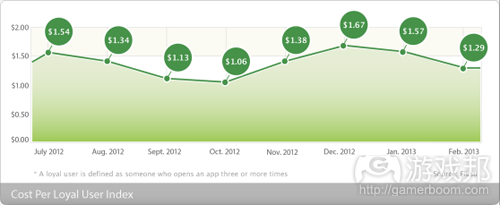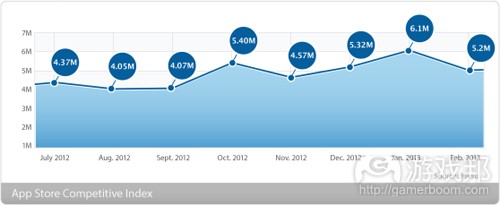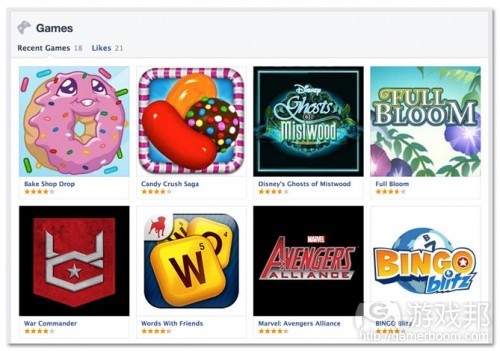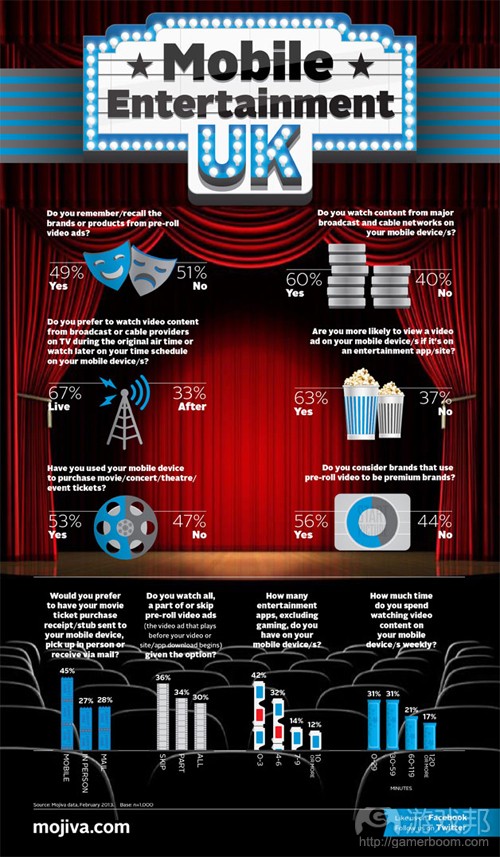每日观察:关注苹果将发布游戏控制器传闻(3.30)
1)Fiksu最近报告显示,2月份iOS忠实用户获取成为已降至1.29美元(1月份为1.57美元,去年12月份为1.67美元),2月份iOS应用日均下载量也降至520万次(1月份为532万次,去年12月份为610万次)。
原因在于去年假期季智能手机和平板电脑应用下载量飙升,1月份开发者获取新用户的成本也随之攀升,2月份这一数据则开始明显下降。
2)据insidemobileapps报道,SundayToz创及首席执行官Kevin Lee在最近采访中表示,公司旗下连线消除游戏《Anipang》目前日收益约50万美元。
该游戏发布于2012年7月,全球下载量已超过2500万次(多数来自韩国)。这款游戏通过韩国通信应用Kakao Talk游戏平台发布,在该平台移动端的日活跃用户达2000万。
3)据Techcrunch报道,芬兰开发商Supercell日前宣布通过Institutional Venture Partners, Atomico和Index Ventures融资1亿至1.5亿美元(相当于Supercell公司16-20%的股份),目前其身价已达8亿美元,该公司首轮风投融资是在2011年5月(当时融资1200万美元),那时Supercell正向Facebook开发游戏。
Supercell目前仅向iOS投放两款游戏,日均收益超过100万美元,这个90人的团队实际上并不缺钱;观察者认为Supercell本次融资举措很可能意在为股东提供更稳定公司所有权(假如Supercell将来进行IPO),也有可能是为公司将来的收购计划作铺垫。
4)据pocketgamer报道,在最近的GDC大会上有传闻称苹果将发布专用游戏控制器,尽管该公司并未发布官方消息,但不少开发者声称苹果确实在GDC游说开发者支持这种苹果产品。
据称苹果可能在4月份的新闻发布会上宣布这一计划,还有一名开发者声称谷歌也将在不久宣布推出其官方版游戏控制器产品。
5)据Mashable报道,尽管Windows Phone设备目前市场份额仅为3%,但微软公关主管Frank Shaw在最近宣布2012年第四季度该设备在7个国家的销量超过了iPhone。
但根据《纽约时报》从IDC获取的数据来看,这7个国家中有一个是中东欧小国,另外6个分别是阿根庭、印度、波兰、俄罗斯、南非和乌克兰。
6)据insidesocialgames报道,Facebook最近添加了一个新模块,用于显示“用户正在玩的社交游戏Timeline页面”。这个游戏模块类似于Facebook本月初重新设计的电影、书籍、电视和音乐模块,呈现了玩家最近玩过或者“赞”过的社交游戏,但与其他娱乐内容模块不同的是,它并不包含用户“想玩”游戏的列表。
Facebook表示这个游戏模块会显示用户在过去30天中至少玩过一次或者赞过一次的游戏。开发者无需调整代码以让游戏显示于该模块,他们只需针对应用自定义一个“收藏”模块,以便用户查看自己在特定游戏中的成就。
在此之前,Facebook曾允许用户筛选仅针对游戏的Timeline活动,但这个选项并不易于发现,也无法提或流量。
7)据MacFan报道,苹果可能在今年6月20日宣布推出新iPhone(即iPhone 5S),并在7月份发售这一新产品。
苹果iPhone 3G发布于2008年7月11日,2009年6月19日发布iPhone 3GS,2010年6月24日发布iPhone 4,16个月之后(2011年10月14日)发布iPhone 4S,2012年9月21日发布iPhone 5。
如果这一消息成真,iPhone 5S与iPhone 5发布仅相隔8个月,这意味着苹果确已加快产品升级换代速度。
8)Mojiva最近发布的信息图表显示,58%英国用户的手机上至少安装4款娱乐应用,12%至少安装了10款此类应用。
60%用户喜欢通过移动设备查看主流网站的娱乐内容,67%喜欢观看到点播映内容。62%智能手机用户每周通过移动设备观看视频内容的时间达1小时,17%每周至少90分钟。
53%用户在最近数月曾通过移动设备购票,45%选择购买电子票据。
64%英国人会在视频播放之前观看部分或全部广告内容,但仅有49%表示自己记得住这些广告。63%表示自己更有可能观看出现在娱乐应用或者网站中的广告视频。
(本文为游戏邦/gamerboom.com编译,拒绝任何不保留版权的转载,如需转载请联系:游戏邦)
1)App marketing costs fall back to Earth after holiday highs
Jeffrey Grubb
Last year’s holiday season saw smartphone and tablet owners downloading apps and games at rocket’s pace. This pushed the marketing cost for developers to acquire new users up in January.
In February, those numbers finally started to significantly recede.
Fiksu, the developer of the app marketing platform of the same name, revealed that the cost for a developer to acquire a loyal customer dropped to $1.29 in February. That’s down from $1.57 in January and $1.67 in December.
In addition to the drop in marketing costs, downloading habits slowed to an average of 5.2 million daily downloads in February, according to Fiksu’s App Store Competitive Index. As new smartphone and tablet owners came online in late December and January, they pushed that figure to 5.32 million and 6.1 million, respectively.(source:venturebeat)
2)The Candy Crush Saga of Korea: SundayToz’s Anipang generating $500,000 a day
Scott Reyburn
Anipang app iconWhile the eyes of the mobile development community at the 2013 Game Developers Conference in San Francisco are set on King’s Candy Crush Saga, SundayToz’s match-3 puzzler Anipang has silently been tearing up the Korean market on mobile for quite some time, the same way Candy Crush Saga is in the U.S. and other parts of the world. We sat down with SundayToz founder and CEO Kevin Lee, who told Inside Mobile Apps that Anipang is generating around $500,000 in revenue a day.
Anipang, which released in July 2012 and has already surpassed 25 million downloads worldwide (mostly from Korea), is a match-3 puzzle game where users play a one-minute round, where the objective is to get the highest score possible.
SundayToz was the first developer to get its game on messaging app KakaoTalk’s game platform. Lee tells us he spoke with the founder of the Korean company Kakao, and proposed the idea to turn the messenger app into a game platform, which led to the launch of Anipang for Kakao, and the rest is history. SundayToz tweaked around the viral mechanic for Anipang to fit with the messaging platform. That viral mechanic created for Anipang for Kakao was called “hearts.” Through a message via KakaoTalk, a user could send a “heart” to another user, if someone clicks the heart and they haven’t downloaded the game, the user will be sent to a page to download the game.
These hearts aren’t just a viral mechanic, hearts act as a token to play the game — one heart equals one round of gameplay. Receiving a message from another person isn’t the only way to receive a heart, a new heart token generates every eight minutes within the game. Leaderboards, which are refreshed every week, keep players motivated by seeing who is at the top of the leaderboard, which consists of a user’s list of contacts from their address book that Kakao utilizes for its social graph. Anipang monetizes by allowing users to purchase hearts to play more game rounds.Anipang banner
“When we first launched on the Kakao platform, the retention was over 80 percent,” Lee says. “It was crazy because no other games except Anipang was there.”
Anipang for Kakao went from no users to 20 million daily active users on mobile with no advertisement spend whatsoever. Keep in mind that South Korea has a population of about 50 million people. Everybody in Korea was playing the game from children to the elderly. The game also saw one-day retention of about 60 percent.
“Two months later, even my mom was playing my game,” Lee says.
In the summer of 2012, Anipang broke the peak concurrency record in Korea held by Nexon’s MapleStory at just under one million, smashing the record by twofold with three million users
playing Anipang simultaneously.(source:insidemobileapps)
3)Top grossing western developer Supercell now valued at $800 million
by Jon Jordan
When you’re hot in the mobile games space, you’re really hot.
That’s the conclusion from Supercell’s latest funding round.
The Finnish developer of Clash of Clans and Hay Day has reportedly sold a chunk of its stock to existing investors Institutional Venture Partners, Atomico and Index Ventures.
According to TechCrunch, which broke the story, Supercell is now valued at $800 million, with the new investment round raising between $100 to $150 million for between 16 to 20 percent of company equity.
The company’s first VC round gained it $12 million from the likes of Accel Partners back in May 2011. Back then it was developing games for Facebook.
Get cash when you don’t need it
The background to the move is Supercell’s amazing ability to make cash.
It only has two games available, and only on iOS, but is generally thought to be generating more than $1 million per day.
Ironically, this means that the 90-strong team doesn’t actually need the investment in terms of operations, marketing or user acquisition.
Instead the deal more likely occurred to enable the founders and original set of investors to cash out with serious money, while providing the larger venture capitalists more stability in terms of their ownership for whatever happens next to the company (especially if it decides to IPO in the medium term).
The only other alternative would be for Supercell to start making some serious acquisitions with the cash to boost its position in a very fast growing market, although this seems more unlikely.(source:pocketgamer)
4)Exclusive: Apple will launch an official gaming joypad soon
by Jon Jordan
Long rumoured – and hoped for – GDC 2013 has finally provided confirmation that Apple will release its own dedicated game controller.
Of course, there’s no official word yet, but Apple has been active during the conference talking to developers about its plans and ensuring plenty of games will support the joypad at launch.
It’s been operating a meeting room at the show, albeit booked under a pseudonym company name to avoid media attention.
However, speaking anonymously, multiple developer sources have confirmed the news to PocketGamer.biz.
In the hand
It’s expected Apple will formally announce its plans during its annual April press event; previously this has been centred around the iPad.
Many things remain unknown, though.
None of our contacts had seen or held the physical device so we don’t know if the pad will take a conventional approach or employ a radical new design.
Following recent mishaps, Apple doesn’t let unreleased hardware leave its closely guarded offices.
Neither are we sure when the pad will be released.
It would be logical for it to hit retail alongside a new iPad, but given the opportunities a dedicated controller would provide in the living room, we’d expect it to be part of a large announcement also revealing Apple’s wide TV strategy, including a direct assault on the console businesses of Sony and Microsoft.
Everybody plays the joypad game
The news follows on from an explosion in third-party controllers from iOS and Android devices during 2012.
This has come from dedicated peripheral companies like MOGA and Nyko, as well as start ups such as Green Throttle, and even unconsole players like Ouya and GameStick, for whom a physical controller is a vital part of their plans to disrupt the console business.
Another example of the important of a game pad to big business was Samsung’s surprise announcement of its Game Pad at the Galaxy S4 launch.
And to complete the picture, one developer source also told us that Google will be making its own announcement about an official game controller in the near future too. (source:
pocketgamer)
5)Windows Phone outsold iPhone in seven countries during Q4
by Daniel Gumble
Microsoft mobile OS still only holds around three per cent market share.
While Windows Phone devices may only account for around three per cent market share, it was announced this week that smartphones on the Microsoft mobile OS outstripped iPhone in seven countries during Q4, Mashable has reported.
The announcement was made via a blog post from Frank Shaw, Microsoft’s head of public relations.
However, after The New York Times asked IDC – the research company that provided the data – which countries saw Windows Phone outsell iPhone, it emerged that one of the seven countries was, in fact, a group of smaller countries categorised as ‘the rest of central and Eastern Europe’.
The other six countries proper were Argentina, India, Poland, Russia, South Africa and Ukraine.
To contextualise the stats, IDC analyst Kevin Restivo pointed out that Windows Phone sold less than 100,000 units during Q4 2012 in Ukraine, South Africa and ‘the rest of central and eastern Europe’.
He also noted that Windows Phone performs expecially well in nations that are renowned strongholds for Nokia.(source:mobile-ent)
6)Facebook rolling out games section of Timeline
Brittany Darwell
Facebook is adding a new section to users’ About pages on their Timeline that showcases the social games they play.
The games section is similar to the movies, books, TV and music sections launched with the latest profile redesign earlier this month. It displays the games users have recently played and all those that they’ve Liked. Users can customize the order of their About page to feature games more prominently near the top or hide it completely.
However, unlike those other sections for entertainment, the games section does not include a list of games users “want to play.”
Facebook says the games section will appear for users who have played at least one social game in the last 30 days or who have Liked a game’s fan page.
Developers do not need to make any code changes for their games to appear in this section. However, they can create custom “collections,” standalone sections for their app so that users can highlight their achievements in a particular game. This requires some configuration and approval by Facebook. Here is a non-game example from Foursquare:
Previously, Facebook allowed users to sort their Timeline by games-only activity, which would show summaries about the games they played, levels they passed or virtual goods they collected, for example. This option wasn’t easily discoverable and likely didn’t help drive traffic to games. Facebook also occasionally displayed a “games report” module directly on Timeline, but users couldn’t control where it appeared on their profile or if it showed up at all. The new games and app collections seemed aimed at giving users more options to show off what is most important to them and increase app discovery with more compelling images and easier-to-find modules.
Earlier this week Facebook announced that more than 250 million people are playing games on the social network every month. The company says game installs on the web platform are up 75 percent from where they were in March 2012.(source:insidesocialgames)
7)Rumor: iPhone 5S to launch June 20, just 8 months after iPhone 5
John Koetsier
Apple’s iPhone 3G was released on July 11, 2008, and followed a little more than a year later by the faster 3GS on June 19, 2009. The iPhone 4 was released on June 24, 2010, and followed
by the 4S sixteen months later on October 14, 2011. The iPhone 5 was launched on September 21, 2012, and if a rumor from Japan is correct, it will also be followed by a 5S model, to be released on June 20.
That is just an eight-month gap.
According to MacFan, a Japanese Apple fanzine that is celebrating its 20th anniversary, June 20 is the announce date of the newest iPhone, which will then ship in volume in July. How exactly a Japanese fanzine would be in possession of that privileged information is difficult to determine, but the timetable does square with analyst expectations. As CNet notes, Gene
Munster and other Apple followers have identified June as the most likely launch window for the 5S.
If accurate, that’s a lot quicker than Apple has brought out upgrades in the past. But the pace of innovation has quickened, and the competition is getting hotter.
Samsung just recently unveiled its Galaxy S IV, the successor to its best-selling Galaxy S III, and the Korean manufacturer’s flagship phone against which Apple’s current iPhone 5 and next models will be compared. Samsung had released the S III in May of 2012, so the IV came out just ten months after — a much quicker model succession than Apple has traditionally managed. In addition, Galaxy IV pre-orders were 446 percent higher than III, at least for some carriers, and iPhone trade-ins doubled in the month leading up to the IV’s launch.
In other words, the Galaxy S IV is a major competitive threat, and Apple needs to address it. Which makes the June-July timeframe credible, even if the actual launch date is not June 20.
The only question, really, is whether Apple is prepared to run a quarterback sneak and maybe, just maybe, release multiple iPhone models simultaneously for the first time. With one that is
a bit cheaper for emerging markets – the cheaper iPhone that is supposed to come out in the latter half of 2013.(source:venturebeat)
8)INFOGRAPHIC: 58pc of consumers own four or more entertainment apps
by Daniel Gumble
2 per cent have ten or more on their mobile.
With mobile spending expected to double over the next 12 months – of which a significant portion is set to be spent on entertainment services – mobile advertising firm Mojiva has produced
the following infographic to illustrate how UK consumers are using their mobile devices for entertainment purposes.
Mojiva’s report found that 58 per cent of consumers have four or more entertainment apps on their mobiles, while 12 per cent have ten or more.
It also revealed 60 per cent of mobile users like to watch content from major networks on their device, despite 67 per cent stating that they would prefer to watch it live at the time of broadcast.
Furthermore, 62 per cent of smartphone users claim to watch up to one hour per week watching video content on their device, with 17 per cent watching at least 90 minutes or more every week.
Elsewhere, the report shows that 53 per cent of consumers have purchased event tickets via their mobile in recent months, and that 45 per cent choose to keep their ticket on their device instead of having a physical ticket.
With regards to ads, 64 per cent of Brits will watch all or part of adverts shown prior to a video, although only 49 per cent said that they could remember the brands shown.
However, 63 per cent stated that they would be more likely to view a video ad on their phone if it was on an entertainment app or site.(source:mobile-ent)

















































 闽公网安备35020302001549号
闽公网安备35020302001549号